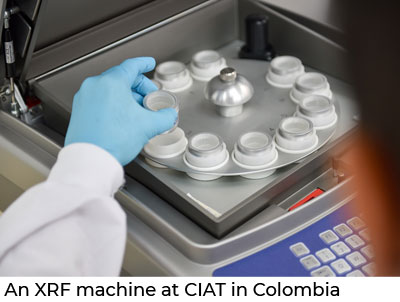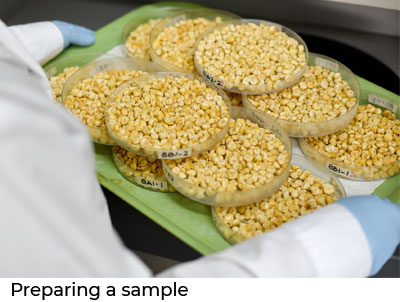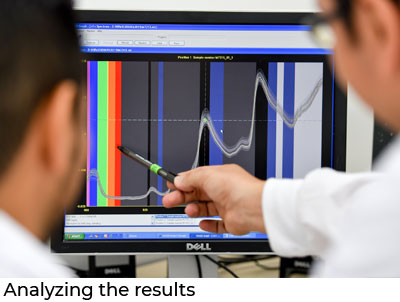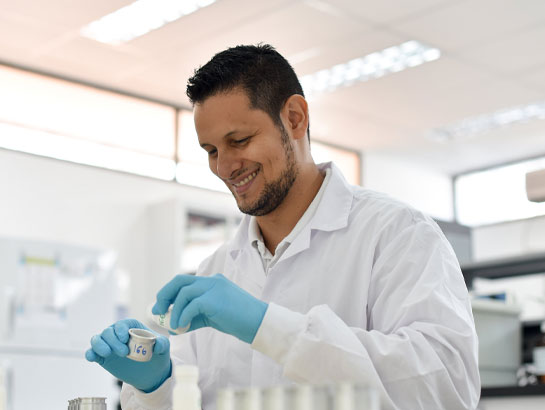HarvestPlus and its CGIAR crop breeding partners are constantly innovating and embracing new technologies to accelerate and refine the process of breeding nutrient-enriched crops for vulnerable farming communities across the world. One such innovation is the adaptation and promotion of the X-ray fluorescence (XRF) machine, which is commonly used in the mining industry, for high-throughput screening of the mineral content of crops.
The introduction of the XRF into the breeding process has been a game-changer in the development of staple crops that are biofortified with minerals (particularly iron and zinc) to help combat malnutrition.
In the breeding process for biofortification, crop researchers have to analyze thousands of germplasm samples in genebanks to find crop breeding candidates that already contain relatively higher levels of a targeted micronutrient. The XRF greatly accelerates the screening process for target minerals, and is also used to confirm mineral levels in bred varieties.
Fighting malnutrition with biofortified crops
Globally, more than 2 billion people suffer from micronutrient deficiencies—a condition known as hidden hunger. Those suffering from this invisible form of undernutrition are vulnerable to blindness, impaired physical and cognitive development, disease, and even premature death. Smallholder farming families in low- and middle-income countries often cannot afford to eat sufficient volumes of fruits and vegetables, high-quality proteins, vitamin supplements and processed food fortified with micronutrients are often sadly out of reach.
In collaboration with many partners, HarvestPlus and the CGIAR crop breeding centers develop and promote micronutrient-rich varieties of staple food crops with higher amounts of provitamin A, iron, or zinc—three of the micronutrients identified by the World Health Organization as most lacking in diets globally. The process is known as biofortification—and regular consumption of these innovative crops is improving nutrition and public health.
Crops promoted by HarvestPlus that are biofortified with minerals include iron beans and pearl millet, and zinc maize, rice, and wheat. HarvestPlus has also contribured to the development of lentil, sorghum, and cowpea varieites that are rich in both iron and zinc.
Measuring Minerals before the XRF: a history
There were several methods to evaluate samples (experimental variaties) in crop improvement before use of the XRF, which began in the early 2010s:
 The gold standard for elemental analysis of plant tissues is a process called inductively coupled plasma-optical emission spectrometry (ICP-OES), however it requires expensive equipment, highly trained analysts, contamination-free reagents, and extensive sample preparation. Building ICP-OES capacity in partners programs is usually not feasible, and the high costs per sample prohibit its use in screening large numbers of samples in biofortification breeding programs.
The gold standard for elemental analysis of plant tissues is a process called inductively coupled plasma-optical emission spectrometry (ICP-OES), however it requires expensive equipment, highly trained analysts, contamination-free reagents, and extensive sample preparation. Building ICP-OES capacity in partners programs is usually not feasible, and the high costs per sample prohibit its use in screening large numbers of samples in biofortification breeding programs.
The very first high-throughput methods established in 2005 were more focused on qualitative measurement, making use of colorimetric evaluations, with the aim of validating the concentration of micronutrients. Other approaches involved semi-quantitative methods such as software capable of analyzing the micronutrient content of the seeds through images. These methods were not precise enough for crop improvement due their qualitative nature or poor reliability.
Atomic absortion spectroscopy (AAS) became a good alternative during earlier phases of the HarvestPlus project, however the method was expensive and slow; only one element could be screened at a time and only process a few dozen samples per day. This method also involved acid digestion of samples that generated toxic waste, making it user and environmentally unfriendly.
XRF Machines: how do they work?
The XRF machines use cutting edge technology for speedier identification of the best seeds with the mineral content needed for breeding, thus saving time and money for researchers. The XRF technology uses X-rays to analyze elements, and is considered a more efficient and cost-effective alternative to other technologies available to crop breeders.
When the XRF passes X-rays through a crop sample, the mineral nutrients in the sample emit X-rays that are different than the incoming X-rays. The outgoing X-rays are characteristic of that mineral, facilitating determination of the crops’ nutrient content. Technically, this is called the “indirect measurement of element.” XRF machines need to be calibrated with a standard curve, which is generated using ICP-OES data for a diverse range of germplasm with varied micronutrient concentrations, for each of the crops and nutrients. Typically, seed samples are used for this purpose.
The XRF machine normally requires only 30 seconds to 1 minute to evaluate a sample. The machines can be easily utilized by breeders without damaging the seed sample, to collect mineral information that is compared with benchmarked varieties. The XRF method is very popular with breeders in various CGIAR centers, National Agricultural Research Systems (NARS), and State Agricultural Universities.
 The next step for breeders is to select the best parental materials for crossing to produce elite breeding materials with the desired traits. The promising candidate varieties advance to what is called gene-environment interaction testing (GxE) in the crops’ target release area for regional and local testing. During testing, crop market preferences are also taken into account as a relevant indicator. The most promising materials are then evaulated in national varietal release trials, and eventually released for commercial production by the official authorities.
The next step for breeders is to select the best parental materials for crossing to produce elite breeding materials with the desired traits. The promising candidate varieties advance to what is called gene-environment interaction testing (GxE) in the crops’ target release area for regional and local testing. During testing, crop market preferences are also taken into account as a relevant indicator. The most promising materials are then evaulated in national varietal release trials, and eventually released for commercial production by the official authorities.
The entire process hinges on having reliable, cheap, high-throughput, and effective methods of selection for all the traits that can form a single package capable of generating profitable varieties in country-crop specific contexts. The XRF machines come both as bench-top and portable devices that can be easily used in laboratories and field settings. All mineral-biofortified crops have benefited from the introduction of the XRF. Currently, there are 22 XRF labs set up in 15 countries across the globe.
“From 2014 to 2019, we have analyzed about 33,000 maize samples using XRF instruments to measure iron and zinc content in maize. Most of the samples were from our Nutritious Zn maize breeding program at CIMMYT, but about 30 percent of the samples were from partners in Africa, and Central and South America. Last year, we analyzed around 1000 samples, an amount that would have been almost impossible to do by ICP-OES under the restrictions by the COVID-19 pandemic,” said Aldo Rosales, a research assistant in the Maize Quality Laboratory at International Maize and Wheat Improvement Center (CIMMYT).
Making XRF technology accessible: Examples from the field
HarvestPlus is committed to building the capacity of NARS; as part of doing so, HarvestPlus makes XRF laboratories and tools available to partner organizations involved in analyzing and developing zinc- and iron-rich crops. HarvestPlus brings in experts to train local scientists in the use of XRF machines and other technologies.
 For example, HarvestPlus provided the first XRF machine to the Bangladesh Rice Research Institute (BRRI). In 2015, HarvestPlus provided a second machine and launched a testing facility in Bangladesh to support faster breeding of zinc rice, and trained scientists in the use of advanced screening techniques. The XRF laboratory center is located at HarvestPlus’ regional office in Bogra. The facility is the first of its kind in Bangladesh and boasts an XRF machine that has been instrumental in supporting the efforts to improve the nutrient content of rice, a staple in Bangladesh. HarvestPlus made the XRF laboratory available to partner organizations involved in analyzing and developing zinc and iron content in rice and wheat.
For example, HarvestPlus provided the first XRF machine to the Bangladesh Rice Research Institute (BRRI). In 2015, HarvestPlus provided a second machine and launched a testing facility in Bangladesh to support faster breeding of zinc rice, and trained scientists in the use of advanced screening techniques. The XRF laboratory center is located at HarvestPlus’ regional office in Bogra. The facility is the first of its kind in Bangladesh and boasts an XRF machine that has been instrumental in supporting the efforts to improve the nutrient content of rice, a staple in Bangladesh. HarvestPlus made the XRF laboratory available to partner organizations involved in analyzing and developing zinc and iron content in rice and wheat.
XRF was first introduced for agriculture in 2011, in India at the International Crops Research Institute for the Semi-Arid Tropics (ICRISAT). This was part of a HarvestPlus capacity building project led by James Stangoulis, who is now at Flinders University. A recently-lauched online platform aims to automate access to testing facilities and obtaining results.
“XRF has been instrumental to support the breeding program for nutritious zinc maize. It has proven to be a high-throughput, robust, and cost-effective methodology. The correlation between XRF data and ICP-OES is about 0.8, which give us enough confidence to discard the low micronutrient values in our breeding program. Also given its flexibility and feasibility, it can be relatively easily implemented in other laboratories with basic analytical infrastructure and capacity,” said Natalia Palacios, maize quality specialist at CIMMYT.
The way forward
Work is under way on the development of handheld XRF machines that could be used to confirm mineral levels in biofortified grain, helping confirm the authenticity of biofortified varieties in the marketplace.
“The use of high-performance technologies such as XRF-ED (Energy Dispersive X-ray Fluorescence) helps plant breeders to have first-hand mineral analysis from field trials with reliable results. Up to 140 samples can be analyzed daily with a minimum of processing, consumable costs are very low and the technique allows samples to be saved as it is a non-destructive technique. With the new models of equipment, it has been possible to reach this analysis efficiency because its components can perform faster measurements and with more precise results,” said Luis Londoño, Coordinator of the Nutrition Quality Lab of HarvestPlus in International Center for Tropical Agriculture (CIAT).
